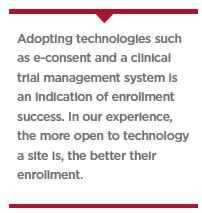Perhaps the single most important consideration in selecting a site is whether it can make its enrollment. Many don’t; in fact, 20% to 25% of all clinical studies close because they fail to meet enrollment targets.1
For decades, sponsors have found their “best fit" sites and returned to them for future studies. But in the era of precision medicine, that may not always be the best course of action. It is becoming increasingly necessary to turn to untapped resources to find potential enrollees.
According to Tufts research, sponsors and CROs report that 28% of their sites are new  relationships with no prior history or familiarity. Those relationships can be tricky. The overall site initiation cycle time is nearly 10 weeks longer for new sites compared to repeat or familiar ones.2 Moreover, sites with insufficient experience are more likely to violate protocols or have low-quality data, which leads to more on-site visits and more request for clarification — even additional training.3
relationships with no prior history or familiarity. Those relationships can be tricky. The overall site initiation cycle time is nearly 10 weeks longer for new sites compared to repeat or familiar ones.2 Moreover, sites with insufficient experience are more likely to violate protocols or have low-quality data, which leads to more on-site visits and more request for clarification — even additional training.3
Finding the Right Sites
In this environment, how do sponsors determine the best-fit sites for their studies? Much of what constitutes “best fit" is specific to the study and the patient population, but here are five characteristics that apply more broadly:
1. Strong Record of Success
Past performance does predict future results. But how much do you really know about past performance of the site or the investigator? Without the right partner, it becomes difficult to assess past performance. With the right partner, however, you have access to verified data — as opposed to self-reported data — to help you make an informed decision.
2. Active Community Presence
No matter how diligently they scour their records and recruit their own patients, no site is going to fully enroll a study from its own patient population. A site that’s active in the community and has built community relationships is more likely to be successful at enrollment.
3. Takes an Integrated Approach
Best-fit sites embrace clinical research as another offering of care to the patient. It’s fully integrated into their practice, and they promote clinical research in a proactive manner  with strategies that may include: showing a list of available clinical trials on a monitor in the waiting room, talking to patients who may be eligible to participate in trials, and engaging their colleagues in the practice to help spread the word.
with strategies that may include: showing a list of available clinical trials on a monitor in the waiting room, talking to patients who may be eligible to participate in trials, and engaging their colleagues in the practice to help spread the word.
4. Dedicated Clinical Research Team
Given that 68% of sites fail to meet their projected enrollment targets,4 you’ll want to ensure the right people are in place to execute against these timelines. Work with your coordinator during the pre-selection visit to determine if they manage too many protocols with too few staff, have a difficult time returning questionnaires in a timely fashion, or have trouble managing responses to ad campaigns. If any of these pop up as red flags, it may be time to bring in a dedicated resource to assist the site team.
5. A Best-fit Site is Open to Innovation
Adopting technologies such as e-consent and a clinical trial management system is an indication of enrollment success. In our experience, the more open to technology a site is, the better their enrollment.
By working with sites that meet the aforementioned criteria, and by availing yourself of the data and other resources available, you can dramatically improve the likelihood that your next clinical trial will succeed.(PV)
Editor’s Notes: 1 WCG Knowledge Base; Data on file; 2 March/April 2018 Tufts CSDD Impact Report; 3 March/April 2018 Tufts CSDD Impact Report; 4 WCG Knowledge Base; Data on file
ThreeWire, part of WCG, is a global patient recruitment, enrollment, and retention firm that uses a systematic, patient-focused approach to help biopharma, medical device companies, and CROs achieve their clinical trial enrollment and retention goals. For more information, visit wcgclinical.com.








